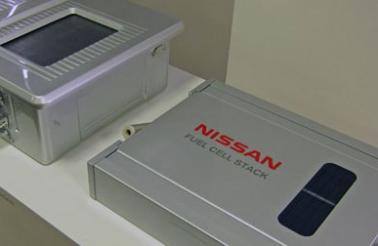
With over 20,000 Leafs running around the planet, Nissan is looking to introduce yet another alt-powered vehicle to the world, and judging by its recent work with fuel cells, a hydrogen-powered vehicle could be here in four year”s time.
Today in Japan, Nissan showed off its next-generation fuel cell stack, the one that the automaker has claimed has the world”s best power density for its size. Compared to the 2005 model (above, left), the new fuel cell (above, right) has 2.5-times more storage capacity while being both smaller and lighter than its predecessor. Weight is down from 265 pounds to just under 90 pounds and output is up to 2.5kW per liter.
This third-generation fuel cell stack makes uses of an improved Membrane Electrode Assembly (MEA), which combined with single-row lamination, has reduced the size by over half. More importantly, the amount of platinum bits inside has been decreased, which means this new cell is about one-sixth the cost of the last generation design. But – and there”s always a “but” when it comes fuel cells – the cost of production is around $50,000. However, that price is set to come down and one engineer confided in us that he”d like to half the size and components yet again, while providing 1.25-times more storage. Considering Nissan”s EV push with the Leaf, we could see the automaker”s first fuel cell vehicle on the market in 2015. Earlier reports said Nissan wanted to launch its fuel cell car at a cost of less than ten million yen ($128,000 U.S. at today”s exchange rate). In its recent “mid-term environmental plan,” Nissan said it plans to sell 1.5 million zero-emission vehicles by 2016 (some coming from Alliance partner Renault). That number includes all-electric vehicles as well as an “all-new fuel cell electric vehicle (FCEV) together with strategic partner, Daimler,” Nissan said in a press release last month. Now about that infrastructure…
Courtesy of http://green.autoblog.com

